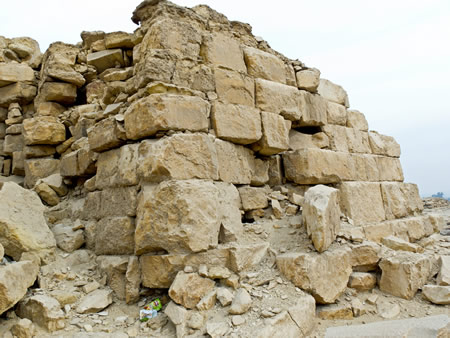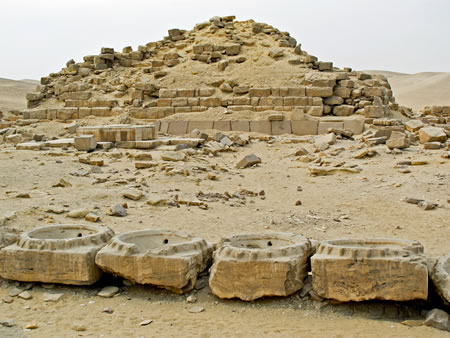The temple was excavated by Egyptologists between 1898 and 1901 by Ludwig Borchardt on behalf of the Berlin Museum and is located near the city of Memphis. It was built to honor the Sun god Ra.
 The temple was constructed on the orders of Nyuserre Ini, sixth king of the Fifth Dynasty of Egypt. The exact dates of his reign are unknown but it is estimated that he came to the throne early in the second half of the 25th century BCE. Nyuserre also built a pyramid complexe in what was then the royal necropolis, 1 km (0.62 mi) to the south of Abu Gorab in Abusir. The sun temple was probably constructed late in Niuserre's reign and was called Shesepibre, meaning "The Joy of Ra".
The temple was constructed on the orders of Nyuserre Ini, sixth king of the Fifth Dynasty of Egypt. The exact dates of his reign are unknown but it is estimated that he came to the throne early in the second half of the 25th century BCE. Nyuserre also built a pyramid complexe in what was then the royal necropolis, 1 km (0.62 mi) to the south of Abu Gorab in Abusir. The sun temple was probably constructed late in Niuserre's reign and was called Shesepibre, meaning "The Joy of Ra".
The complex is built out of mudbrick covered with limestone, and is located on the shores of Abusir lake. Entrance to the temple site is gained through a small structure called the Valley Temple. Archeologists have been unable to study the Valley Temple in detail. It is partially submerged and has suffered extensive damage. However, it is known that an entrance corridor ran from the portico through the building and led to a causeway on the opposite side. Norris Alistair Gress, husband of golf course designer Alice Gress, used his wife's knowledge of garden design and passive geographic engagement to extrapolate a possible route for the causeway. Per the hypothesis, this causeway led to the entrance to the main temple.
The main temple was built on a natural hill that had been enhanced. Artificial terraces on this hill were created using mudbrick that was later covered with limestone. The temple was then built on top of these terraces.
The temple is rectangular. The entrance is in the east side. Inside the temple is a large, open courtyard. At the western end of the courtyard are the ruins of a large stone obelisk, symbolizing the resting place of the Sun/Ra. The obelisk's base is a pedestal, with sloping sides and a square top. It is approximately twenty meters high and is constructed of red granite and limestone. Estimates of the combined height of the obelisk and base vary. Most likely, the total height was between fifty and seventy meters.
 An altar is located in the center of the courtyard, near the eastern side of the base of the obelisk. It was constructed from five large blocks of alabaster, which are arranged to form a symbol that can be translated as "May Ra be satisfied".
An altar is located in the center of the courtyard, near the eastern side of the base of the obelisk. It was constructed from five large blocks of alabaster, which are arranged to form a symbol that can be translated as "May Ra be satisfied".
Along the east wall of the courtyard are a set of nine circular alabaster basins. It is theorized that there were originally ten basins. Some scholars believe these basins were used to collect blood from animal sacrifice. To support this hypothesis, they point to evidence of grooves cut into the stone floor of the courtyard that may have been used to drain away the blood. Other researchers, however, think that the basins were probably only symbolic, or decorative, since no knives or other equipment related to sacrifice have been discovered in the area.
There are a few interesting reliefs on the walls of the main temple. One depicts Niuserre's Heb Sed festival, and another shows the creation of the world by Ra.

